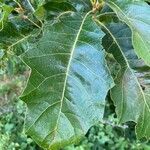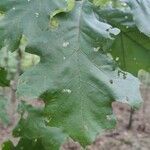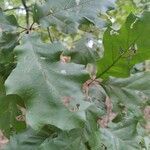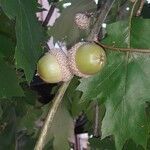A small tree. It grows up to 20 m high. The trunk is 90 cm across. It is clear up to the crown. The leaves are 10-20 cm long. There are 5-7 lobes and the base is rounded. The lobes are oblique to the midrib and have parallel sides. The leaves are shiny dark green above and yellowish-brown and rough underneath. They are hairy when young. The leaf stalks are stout and 7-15 cm long. The acorns are small and 12-20 mm long. The cup is bowl shaped and 12-24 mm across. It encloses about half the nut.





